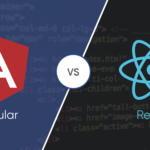Angular and React: Main features and differences

Soccer fans discuss whether they prefer Pelé or Maradona. TV series fans argue whether Game of Thrones or Breaking Bad is better. And, if you’re a rock lover, you’ve probably read hundreds of disputes between The Rolling Stones vs. The Beatles.
The same thing happens in the programming world with Angular and React. Both are perfect for any front-end web development job, even though they don’t serve the same function. Both Angular and React are meant for the same general purpose, but each will have its particular applications.
If you want to understand more about these concepts, it’s essential to dig deep into the features of Angular and React.

The key features of Angular
Angular is an open-source framework that was developed by Google. Its main objective is to be able to create SPA web applications (a single-page website). In the same way, it seeks to generate a comfortable and simple working tool. The data loading is done dynamically, and the development environment is very user-friendly.
Among its main features we can mention:
- Dynamism. Angular allows extending the HTML code to generate new functions, which is helpful to create dynamic templates. Any update in the model will be immediately reflected in the view without the need for event control. In this way, Angular appears as a dynamic working environment.
- Reusable code. This concept is essential to reduce the workload of many developers. Angular will allow you to generate custom HTML tags. Because of that, you can reuse code. For example, you’ll be able to put template HTML blocks back into the same file without any problems.
- Multiple options. Remember: Angular is an open-source framework. All your work can benefit from the development of other professionals. Therefore, you will be able to find answers to queries and doubts, but that’s not all. You will also have many standard features that other libraries would never include.

The main features of React
React was born to be an open-source JavaScript library. Developed by Facebook, the initial operation was limited, as it sought to manage the user interface. However, over the years, it has released numerous updates. Thus, it became a much more complete and competent framework.
For example, some of its main features are:
- Versatility. This library allows you to work from the front end. However, also server-side, as with Next.js or Gatsby.js. In React Native, there is the possibility of being oriented towards the field of mobile development. So React it’s incredibly versatile and, in the future, it will surely add more options.
- React. As the name implies, React allows programming on asynchronous data flow. Therefore, finite or infinite data can propagate and generate changes in the application. Consequently, they can react to data by executing a series of defined events.
- Component-based. React allows you to create components, which generates incredible scalability for all development projects. Furthermore, React has a large number of resources. Because of that, this library will enable you to create simple components but also advanced structures. The more knowledge you have, the better projects you can make.

The most relevant differences between Angular and React
You can already guess that Angular and React can be used for similar things, but they have very marked differences in how they work.
Below, we’ll show you the main ones:
- Library vs. Framework. React is a JavaScript library, but Angular is a framework. Thus, Angular allows a complete solution for web development projects. In contrast, to work with React, it’s expected that you have to bundle it with other libraries.
- JavaScript vs. Typescript. React uses JavaScript since it is a library for creating user interfaces based on that programming language. Angular uses Typescript, which is a static and more structured compiled language. Developers use Typescript to detect errors quickly.
- Unidirectional vs. bidirectional. By this, we mean the data flow. In the case of React, it has a unidirectional data flow. That is, you can only change UI elements after changing the model state. In Angular, the flow is bidirectional. This system explains that if the user interface is changed, the model state will change automatically.
Angular vs. React: which one to choose for your next project
A competent front-end developer should know both tools. However, indeed, you won’t always use both, as it will depend on the characteristics of each project.
Both Angular and React offer a good user experience and outstanding performance. In the same way, both allow good mobile development, and they have a lot of resources and updates, as they have very active communities.
However, Angular may be more suitable for extensive projects. It is a framework, so there will be a large number of options to use. On the other hand, React appears as a very user-friendly library, perfect for small teams and even individual developers.
Now that you know the main differences between Angular and React, you are ready to face your next development projects, knowing that you can make a well-based decision on which will be the best for each case.
Keep reading our blog!


Leave a Reply
You must be logged in to post a comment.